#manila galleon
Text

Sunrise: The Manila Galleon Sailing from Cabo San Lucas, by Mark Myers (1945-)
168 notes
·
View notes
Text
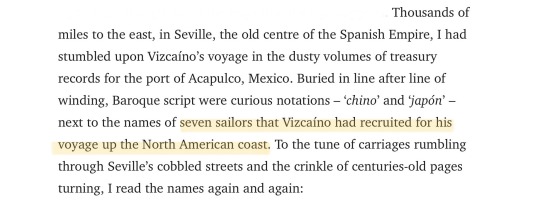



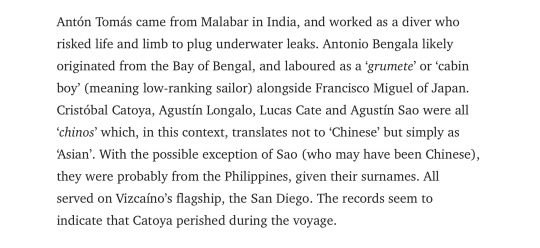
Asians in early America (2023) by Diego Javier Luis on Aeon
22 notes
·
View notes
Text
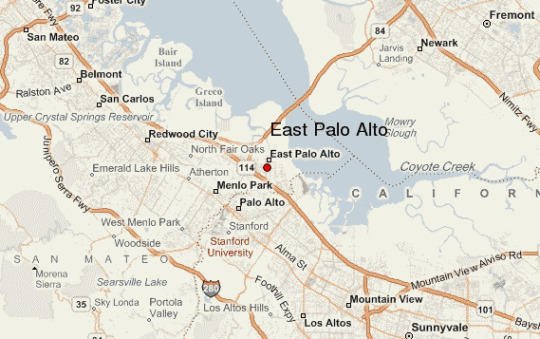
The name Palo Alto in California comes from the fact that during the voyage of the Manila Galleon, the huge sequoia tree there served as a reference for the Spanish sailors to know that they had crossed the Pacific and arrived home. USA has +5000 topographical names provided by Spain.
About the Manila Galleon:
The Manila–Acapulco galleon trade finally began when Spanish navigators Alonso de Arellano and Andrés de Urdaneta discovered the eastward return route in 1565. Sailing as part of the expedition commanded by Miguel López de Legazpi to conquer the Philippines in 1564, Urdaneta was given the task of finding a return route.[10] Reasoning that the trade winds of the Pacific might move in a gyre as the Atlantic winds did, they sailed north, going all the way to the 38th parallel north, off the east coast of Japan, before catching the westerlies that would take them back across the Pacific. He commanded a vessel which completed the eastward voyage in 129 days; this marked the opening of the Manila galleon trade.[11]
Reaching the west coast of North America, Urdaneta's ship, the San Pedro, hit the coast near Santa Catalina Island, California, then followed the shoreline south to San Blas and later to Acapulco, arriving on October 8, 1565.[12] Most of his crew died on the long initial voyage, for which they had not sufficiently provisioned. Arellano, who had taken a more southerly route, had already arrived.
#US history#Spanish history#Manila Galleon#Miguel López de Legazpi#Alonso de Arellano#Andrés de Urdaneta#Santa Catalina Island#California#Acapulco#San Blas#The Philippines#China#The Pacific Ocean
2 notes
·
View notes
Photo

El Tamborilero / The Little Drummer Boy
The earliest known Asian-American settlement in the continental United States is Bayou Saint Malo, Louisiana (1763-1915) founded by deserting sailors and fugitive slaves from Manila, who were uniquely suited to thrive in the inhospitable and remote marshlands using indigenous shrimp fishing techniques and stilt houses from the Philippines. For 250 years (1565-1815) Spanish galleons crossed the Pacific Ocean trading luxury goods and forcibly recruiting and converting colonial subjects from Las Islas Filipinas and the Américas through the ports of Manila and Acapulco under the Viceroyalty of New Spain in México Tenochtitlán.
https://www.inprnt.com/gallery/eirikswood/el-tamborilero-the-little-drummer-boy/
#tamborilero#st malo#saint malo#bayou#aapi#asian art#pinoy#filipino#spanish galleon#manila galleon#oil on wood#drummer boy
16 notes
·
View notes
Link
6 notes
·
View notes
Text

To be fair, how many ships are there in the world with red sails? Beyond those in present day Russia and China, at least.
#I can't verify how frequently sails are painted or printed#she's a spooky ghost hellboat lmao#we can at least argue she's the only Manila Galleon with red sails *shrugs*#[Dashboard Commentary]#[La Demonia Roja]#rosegoldkingdom
2 notes
·
View notes
Text
ACM Unveils Trade Secrets of the Manila Galleon
"Manila Galleon" exhibit at ACM showcases 140+ artifacts linking Asia with the Americas, revealing the rich tapestry of global trade and culture.
via Tatler Asia, 07 February 2024: The Asian Civilisations Museum, in collaboration with the Ayala Museum, presents “Manila Galleon: From Asia to the Americas,” showcasing over 140 objects that trace the historical Pacific trade routes connecting Asia with the Americas and Europe. This exhibition highlights the cultural exchanges and global influences from the 16th to 20th centuries, featuring…
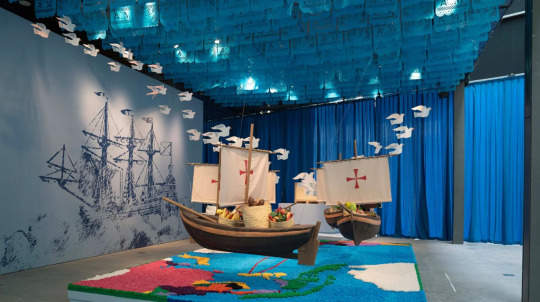
View On WordPress
#Asian Civilisations Museum#Ayala Museum#exhibitions#Manila Galleon Trade#museums#trade and communication networks
0 notes
Text
Asian workshops produced a number of devotional items for people in Spanish America. Many of these were made of meticulously carved ivory, such as this small sculpture of the Virgin Mary, made in the Philippines in the 1700s:

Here’s another Mary, this one probably from Fujian, China:
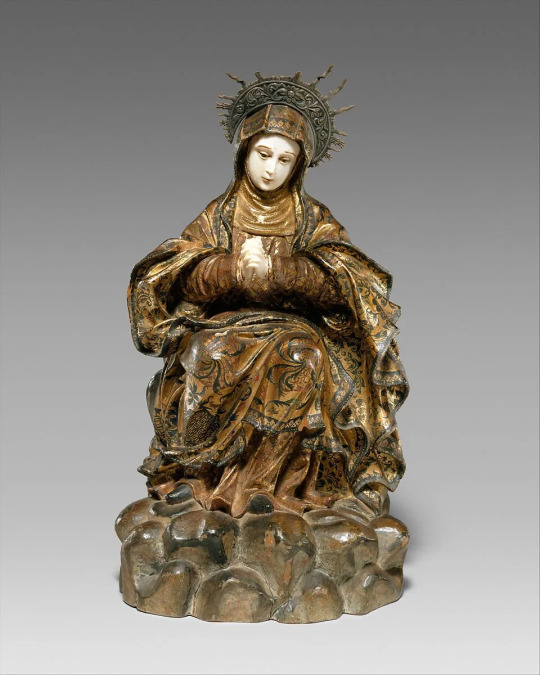
See more, including figures assembled in both Asia and the Americas, here:
{Buy me a coffee} {WHF} {Medium} {Substack}
408 notes
·
View notes
Photo

The Spanish Empire in 1600.
« Atlante storico », Geo-Mondadori, 2000
via cartesdhistoire
The Spanish West Indian Empire was centered in the north on the Viceroyalty of New Spain and in the south on the Viceroyalty of Peru. It was enriched with the Philippine Islands from 1565, after the Spaniards discovered routes enabling them to cross the Pacific Ocean. In 1571, the city of Manila was founded there.
From 1546, the Spanish exploited the mines of Potosi (Upper Peru), from which most of the world's silver was quickly extracted. From 1564, a convoy system of galleons loaded with silver crossed the Atlantic Ocean to reach Spain. In the Pacific, once a year, the Manila Galleon transported silver from the New Spanish port of Acapulco to Manila in the Philippines. It made the return trip from the Philippines to Acapulco, carrying silk, porcelain, and Chinese lacquerware. From the 1590s, the value of this silver crossing the Pacific Ocean equaled all Atlantic trade combined.
75 notes
·
View notes
Text
I knew rice didn't grow in Mexico originally but I didn't know it came from the philippines "Some four decades later [After 1519], Spanish vessels known as the Manila Galleons first brought rice to Mexico from the Philippines." according to this ny times article
yes my dad's self proclaimed "veggie tacos" lead me down a rabbit hole.
first it was "how they make rice noodles anyway" and then dwelling on the 'taco' part of my dad's nonsense "If rice isn't native to Mexico when did it become such a cultural staple?"
72 notes
·
View notes
Text

Cross Section of a Manila Galleon, by Roger Moore
The Manila Galleon (Galeón de Manila) is the name of a Spanish ship that transported goods between Manila, the capital of the Philippines, which was administered as a sub-colony from New Spain, and Acapulco during the Spanish colonial empire.
The name does not refer to a specific type of galleon, but to the port of departure, Manila, from which the ships loaded with goods from the Far East (e.g. precious stones, spices, porcelain, silk) usually set out once a year for Acapulco, where they in turn took silver on board and brought it back to purchase the Far Eastern goods.
The term galleon was used from the 16th to the 19th century and thus continued to be used when even in Spain this type of ship with its building traditions was no longer built.
139 notes
·
View notes
Text
Talokanil Clothing, Part Two
thank you to everyone who engaged with this post!
seeing more bts footage plus reading interviews and doing my own research has had me reevaluating some of my earlier assumptions, so here's a part two!
i've been sitting on the idea that the talokan plant is like a coconut (aka the tree of life in the tropics) equivalent to the talokanil for a while, but i wasn't sure if there was enough canon or real historical equivalent evidence to support this.
this post suggests that early talokanil clothing was made of the talokan plant's fibers. initially i was unsure about this bc i thought it was some kind of succulent, but then i came across this post suggesting it's a type of agave & suddenly everything made sense!
this gets long, but hear me out: agave is endemic to the americas and its variants hold historical and cultural importance in central america (pre-hispanic up to present). it takes a long time to mature, the exact length varying from species to species (hence the moniker century plant), and flowers and seeds only once before dying (radding 2012, 84-115). parts of the agave are edible, but its two most prominent uses are for fibers and alcohol production. two agave cultigens, A. fourcroydes (henequen) and A. sisalana (sisal) are known fiber producers, and are both native to the yucatán (trejo-torres, gann, and christenhusz 2018, 366-379).
another variant, A. americana aka maguey (although it seems the term maguey is can be used to refer to other agave species), also produces fibers that can be used for woven and non-woven textiles and even paper (hulle, kadole, and katkar 2015, 64-75), and is a species of agave that can be used to produce the alcoholic drink mezcal. A. tequilana is the sole agave species used to produce tequila (which i believe can be technically called a type of mezcal). both mezcal & tequila are distilled from the fermented, roasted "hearts" of the agave. the method to distill mezcal (and later, tequila) was introduced during the colonial era, likely by indigenous filipinos who arrived via the manila-acapulco galleon trade (walton 1977, 113-132).
pulque is the pre-colonial equivalent of mezcal/tequila, made from the fermented agave sap (many species can be used). its consumption was highly regulated & associated with religious rituals (escalante et al. 2016). described as a white, slightly viscous liquid, pulque does somewhat call to mind the liquid the shaman made from the talokan plant, although the latter was, of course, blue. this is a side note, but a mural in cholula, puebla, mexico, depicts a gathering of people purportedly drinking pulque. the production team may have taken some inspiration from this as well for the flashback scenes.
the goddess mayahuel is associated with maguey & pulque, as well as femininity & fertility (guzmán 2016). (i'm a bit confused bc wiki says she's aztec, but escalante et al. & guzmán don't give a specific indication. her name though is nahuatl-derived.)
so anyway! we have a wonder plant with cultural and religious significance that can provide both food and clothing, and may even be used in construction (including in composites)! it makes so much sense that the talokan plant is a type of agave, albeit of course one with properties that no irl species has.
i've read several hannah beachler interviews but i haven't come across one where she talks about whether or not there was more of the talokan plant. the rest of this post hinges on the assumption that the talokanil are actively cultivating the plant, or something similar (which i'll be referring to as talokanil agave from now on), so if later canon lore proves me wrong — well, i'll cross that bridge when i get there lol.
for additional context, since i'm only here to speculate on the materials used in-universe, this twitter thread here provides a breakdown as to the accuracy of the clothing styles of the talokanil vis-à-vis pre-colonial maya.
now that's done, let's get to the actual speculation:
i'm inclined to retract my previous assertion that coconut coir was used in the warriors' uniforms; instead, what i took to be coconut coir is probably talokanil agave. (although they could probably still use coconut if they really wanted to!)
when i wrote the first post, i didn't realize how many outfit changes k'uk'ulkan goes through during the talokan scenes, but from what i can tell of the textures, they could all very well be made of talokanil agave or even just regular maguey. while cotton was more associated with elites over maguey in irl pre-colonial mesoamerica (tremain 2020, 1-11), i haven't seen anything yet that would indicate that nobility wouldn't wear maguey.


i'd thought namora's ceremonial dress would be heavy but we see it in action in mabel's ig post and it's actually very light! iris van herpen, the designer, has said in an ig post that the cape feathers are made of silver-lined silk organza. underwater, the effect is something like seagrass or kelp moving with the currents, which is very pretty. when i look up silk in mesoamerica, many of the sites are, strangely, associated with the church of the latter-day saints, but one textile-focused website at least indicates that widespread silk production began and flourished during the colonial era, so i think we can rule out actual silk as the in-universe material for the dress. maybe very high quality cotton or talokanil agave (especially for the silver lining. unless it's vibranium!).


we also see one of namora's surface outfits used underwater in a bts clip from mabel, one which i thought would be too heavy to wear in the water. i mean, i guess, technically, you can wear anything you want underwater, but comfort is a different matter. in my previous post, i'd said i'd thought this particular dress and the others she and the handmaidens wore were made out of some kind of barkcloth, but, surprise, again, it's probably talokanil agave or regular maguey (agave sisal is resistant to seawater).
the twitter thread i mentioned above has some insights into attuma's ceremonial outfit, including that he's wearing a jaguar pelt. the talokanil could very well have some kind of coming-of-age ceremony where they go to the surface for the first time to hunt. or attuma could just be an adrenaline junkie lol. hammerhead sharks, jaguars — it's all the same to him. as for the rest of the outfit, i'm gonna say different grades of talokanil agave bc why not!
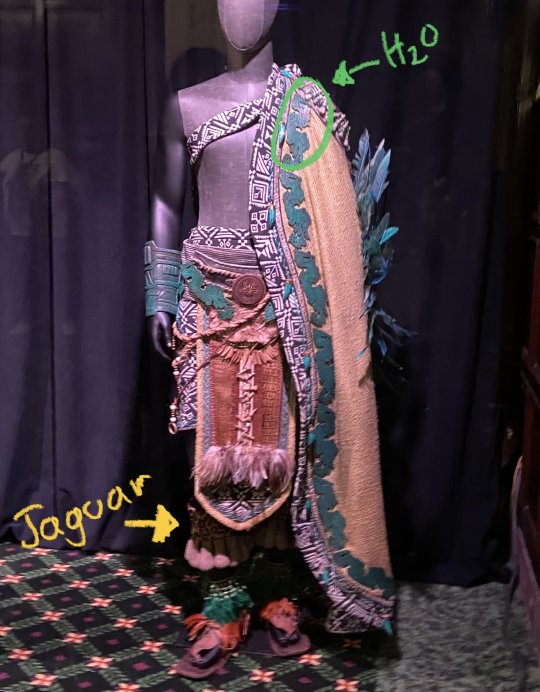
at different points in the film, namora and shuri both wear body jewelry primarily made of jade. iris van herpen has said that shuri's also has pearls and Spondylus shell beads (the orangey-pink ones). namora's doesn't appear to contain Spondylus but perhaps other precious stones (maybe obsidian?). that might indicate some kind of difference in status, or some kind of oblique reference to namora being a warrior, since obsidian was often used for weapons (saunders 2001, 220-236).

shuri's second talokan outfit has feathers on the back, reminiscent of the tail plumes of the resplendent quetzal (yes, as in the bird associated with quetzalcoatl, the aztec equivalent of kukulcan. this man is never beating the egocentric allegations 💀). however, the color is wrong. resplendent quetzals have primarily green plumage & only the males sport the iconic tail feathers. moreover, resplendent quetzals live in the highland rainforests, not the coastal areas. so i'm not sure if this means that the feathers are from a different bird species altogether, or, like namora's headdress, they are not actually feathers but fish fins. i haven't found a high-res enough photo of the outfit so i still can't be sure.
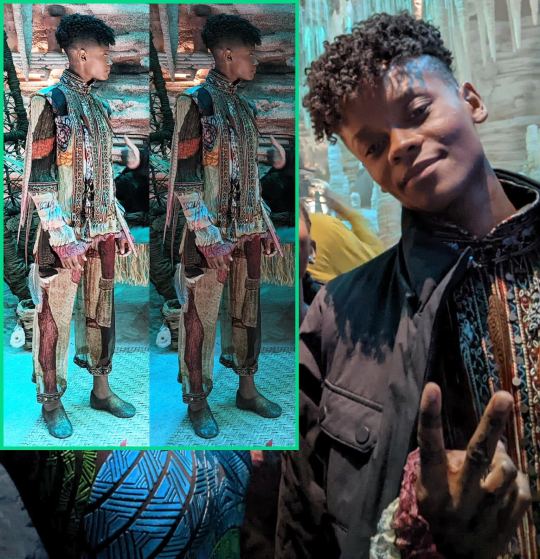
the rest of the outfit appears to be a mix of fabrics, heavier on top and lighter on the bottom. i'm intrigued that the bottom half is pants, because we haven't seen any talokanil wear anything similar. could this be a leftover from the cut scenes where shuri & riri were supposed to work on something for k'uk'ulkan, & this is an outfit she came up with herself? they might have given her the fabric & told her to go to town, which could explain why the design looks very different from what we've seen of talokanil fashion. i think riri also gets a different outfit but i can't find good photos of it.
now her scenes were cut from the final version of the film, but one of the talokanil extras posted some intriguing bts footage. her character was supposed to a scientist (likely from the cut scenes with shuri & riri). she's not blue & isn't wearing face/gill masks, suggesting her parts take place underwater.
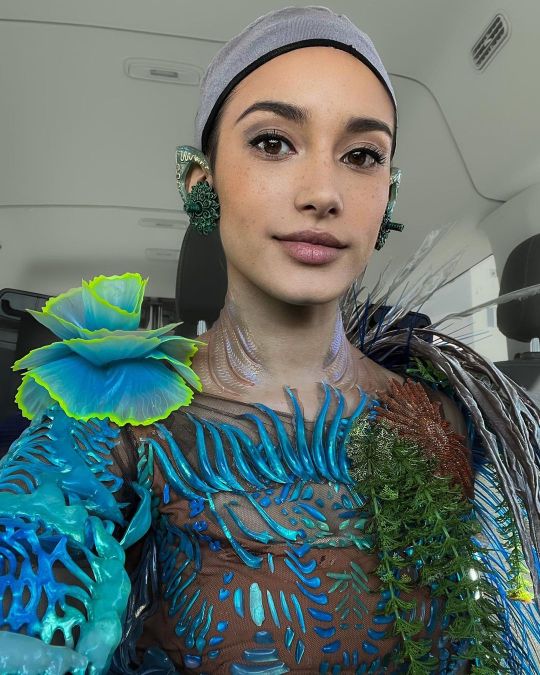

her outfit is pretty unconventional compared to namora's or the handmaidens'. she appears to be wearing more plant life (probably some sort of kelp & seagrass, among other species i don't recognize), but the main body of her outfit looks strangely artificial. i'm not sure if this is intentional or if her final appearance was meant to be tweaked with cgi (the mesh underneath is throwing me off). i would like to say her outfit is probably mostly made of talokanil vibranium, but i'm not sure if that would be realistic in-universe (would that mean she is of high status? another relative of k'uk'ulkan perhaps? or does jade still mean more to the talokanil than vibranium, therefore her use of it doesn't necessarily indicate status?). in any case, she's the only talokanil we're aware of who eschews traditional clothing styles.
additional bts footage from jewelianna ramos-ortiz (the scientist) also show other talokanil who are dressed differently from the regular warriors we see. they aren't blue either, but we do see that they have on red body paint (which we have not seen other talokanil use). google scholar is being reticent but as far as i can tell, body paint in pre-colonial mesoamerica, when not in a funerary context, was associated with ceremonies or festivals. the latter likely used organic compounds such as cochineal or achoite (that's achuete/atsuete for us filipinos), while the former employed the toxic cinnabar (source). with the talokanil, it could really go either way; we don't know if they're as immune to toxins as they are to stab wounds. i'm not sure about the seawater resistance of either type of pigment though.

interestingly, they appear to be wearing the leaves of surface plants (none of which i recognize, unfortunately, even after some googling of native yucatán flora). their different manner of dress may indicate the nature of their role in talokanil society, though as to what that role is remains to be seen.
one funny implication though of practically everyone in talokan wearing talokanil agave is that shuri could've just taken anyone's clothes to re-create the heart-shaped herb, including the ones she was given 💀 but the talokanil still could've cultivated the plant in the past centuries such that the variant they use for clothing differs quite a bit from the original so it wouldn't work as well. like maybe they have a "drink this to save your life. for emergencies only" cultigen & a "for everyday life" cultigen lol.
aaaaand that's it! if you're still reading this, thank you! this was a fun research exercise, although i probably still missed a lot. this was practically a whole damn research paper lmao. let me know your thoughts!
#black panther: wakanda forever#bpwf#wakanda forever#namor#namora#attuma#shuri#riri williams#talokan#i needed to get exorcise this from my brain#calemonsito notes#long post#mcu namor#mcu namora#mcu attuma#mcu k'uk'ulkan#mcu shuri#mcu riri williams#sorry the tone is all over the place my brain couldn't decide if it was writing meta or a scholarly article lmao#'i needed to get exorcise this from my brain'??? lmao sorry i was half-asleep when i posted this
85 notes
·
View notes
Text
hi guysss it's me the adventurous devotee again. i would like to share a blog about my experience in the 42nd Intramuros Grand Marian Procession held this year.


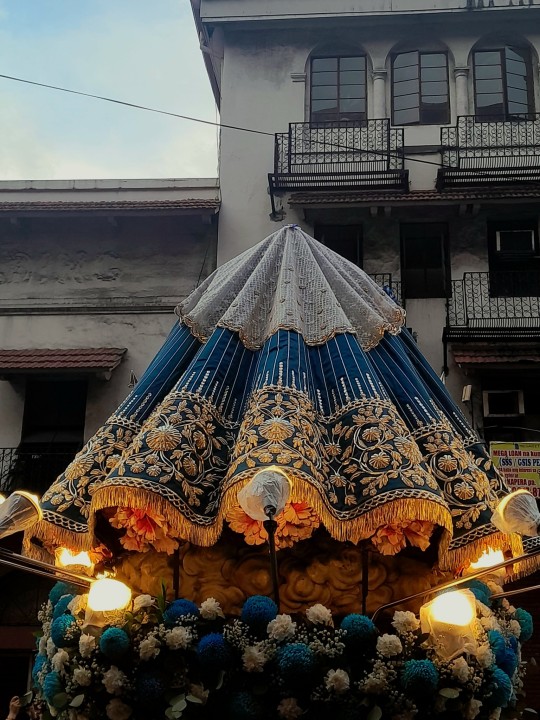

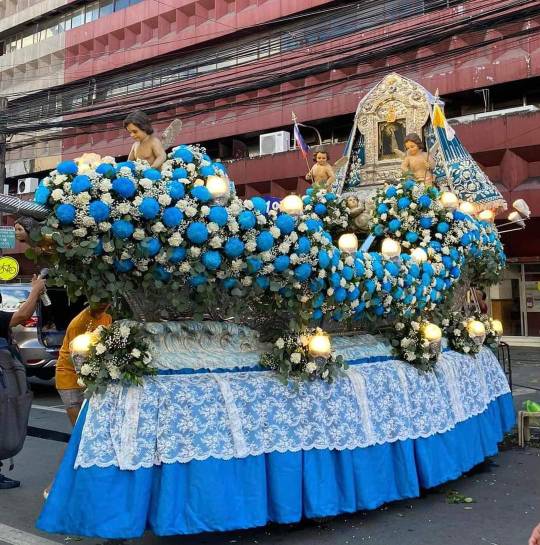
short trivia and information, basically this blog is about the grandest marian procession in the Philippines held in the streets of walled city of intramuros, manila every year in early december. a grand marian procession is the procession of the different images of the Blessed Virgin Mary, the Mother of one true God under different titles from different places in our country. devotees and delegates from different parishes across the country gathers at intramuros to start a solemn and grandiose procession in honor of the feast of the principal patroness of our country, the immaculate conception every first sunday of december every year. the chariots bearing different images of BVM participants are exclusive to those who are invited by the Cofradia de la Inmaculada Concepcion de Intramuros.
let me start to share my experience. so i am from rosario, cavite, but my name is listed in the chariot/galleon carozza of our lady of solitude of porta vaga, cavite city because she is my patroness. together with the cofradia de la virgen de la soledad de porta vaga, we travelled from cavite city to intramuros to participate in the procession in honor of our virgin of solitude. the 350+ painted image of our lady of solitude of porta vaga is greatly venerated and payed respect at plaridel st. san roque cavite city. she is hailed as the queen and protectress of our province. the procession of the our lady of solitude of porta in intramuros started at 6pm, her silver galleon carozza is escorted by the altar servers, the flags, the philippine army, republica filipina reenactment group, the Cofradia, and the devotees. she graced the historic walls of intramuros in full solemnity through the recitation of the spanish rosary and the wearing of black clothes together with candles that lights up the street. the experience is one of a kind considering this event only happens once a year out of town. the procession concluded at muralla street by dismantling of the galleon carozza through the help of cofradia and care takers at 8pm in preparation of the coming home of the venerated painting of the our lady of solitude of porta vaga. i could say that this is the best religious procession I've ever attended. the surreal feeling and experience is unexplainable and beyond words. you could literally feel the presence of our lady just by attending the procession of her image. if i were to asked to rate it, i would rate it infinity over ten. it was an incomparable experience, I'd like to remember it that way.
9 notes
·
View notes
Text
The currency situation in China was very complicated in the 19th century, as there was no unified monetary system. Different parts of China operated different systems, and the Spanish pieces of eight that had been coming from Mexico for a few hundred years on Manila galleons were current along the China coast. Until the 1840s, these silver dollar coins were Spanish coins minted mainly in Mexico City; but from the 1840s, these gave way to Mexican republican dollars.
In Shanghai, this complexity represented a microcosm of the complicated economy existing elsewhere along the China coast. The Chinese reckoned in weights of silver, which did not necessarily correspond to circulating coins. One important unit was a tael, a measurement of weight with several different definitions. These included: Customs Taels (for foreign trade), Cotton Taels (for cotton trade), etc. Shanghai had its own tael, which was very similar in weight to the Customs Tael and therefore popular for international business. China also had a mixture of coins, including Chinese Copper Cash coins and Mexican dollars.
8 notes
·
View notes
Text

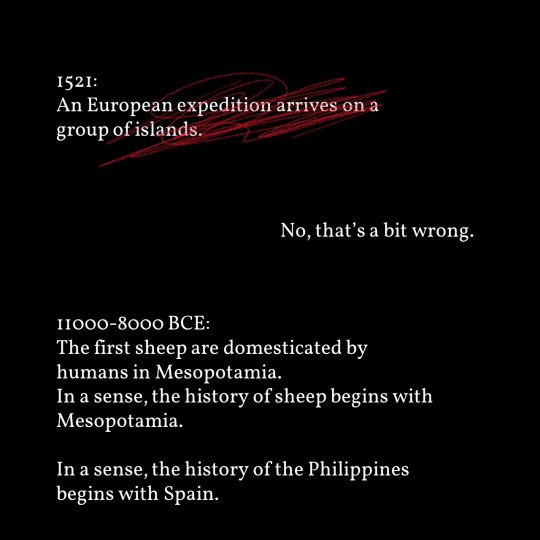
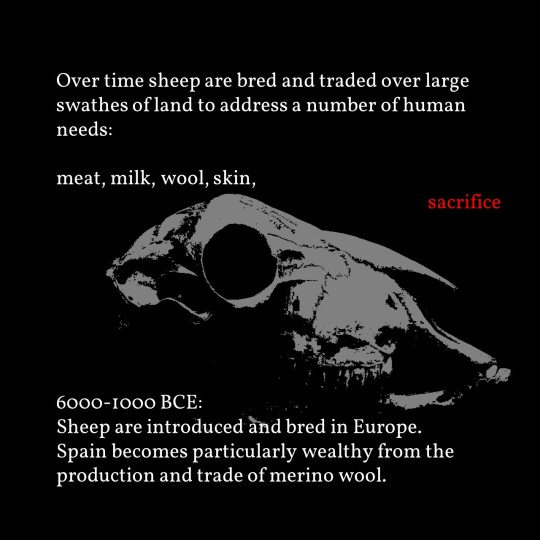
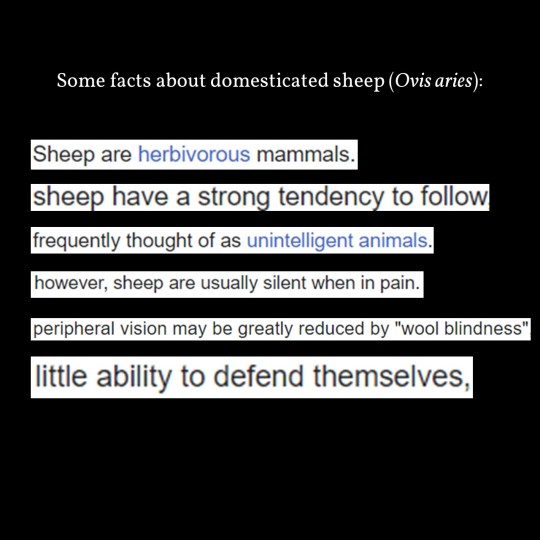
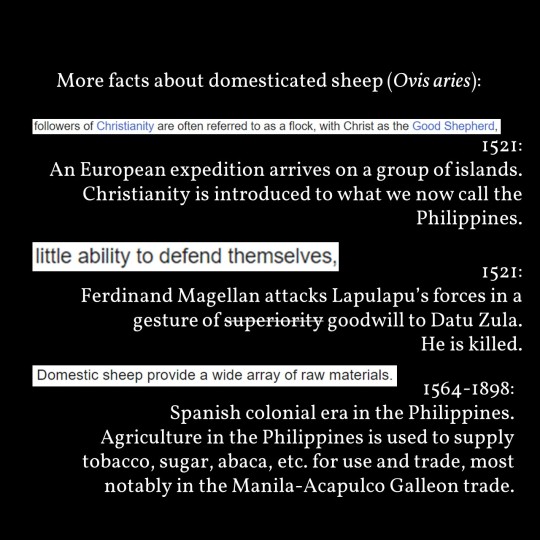
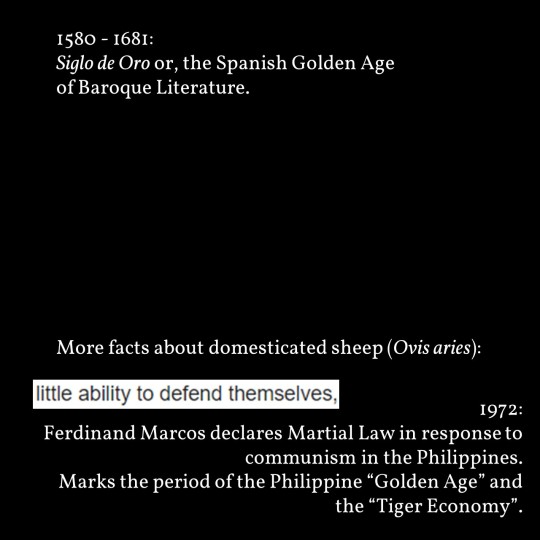
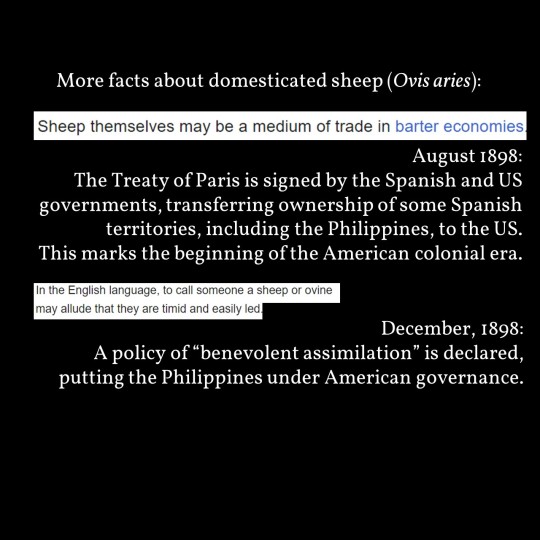
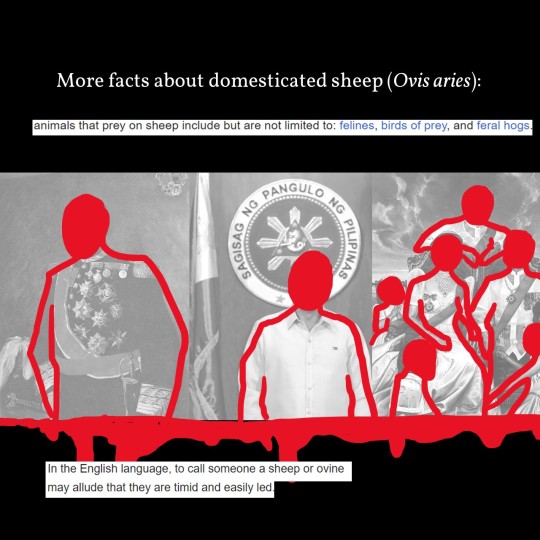



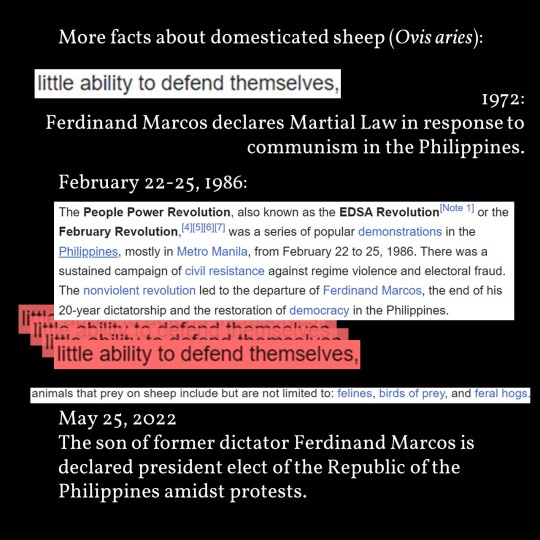

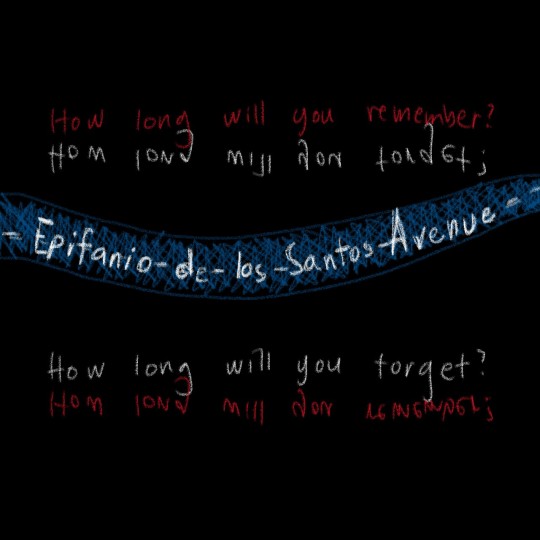

Sheep Eating Tigers: reflections on EDSA and Fuenteovejuna
[ID: a 15 page comic.
Page 1: Sheep Eating Tigers: reflections on EDSA and Fuenteovejuna. 02.25.2023, ika-37 na anibersaryo ng People Power Revolution. The words are in circular form, with illustrations of wounded sheep licking at blood and a tiger with its intestines out surrounding the text. A spiral serves as the backdrop. Several newspapers detailing the EDSA revolution are placed on the bottom of the image.
Page 2: 1521: An European expedition arrives on a group of islands. (This line is crossed out) No that's a bit wrong. 11000-8000 BCE: The first sheep are domesticated by humans in Mesopotamia. In a sense, the history of sheep begins with Mesopotamia. In a sense, the history of the Philippines begins with Spain.
Page 3: Over time sheep are bred and traded over large swathes of land to address a number of human needs: meat, milk, wool, skin, sacrifice. (A sheep skull is in the background) 6000-1000 BCE: Sheep are introduced and bred in Europe. Spain becomes particularly wealthy from the production and trade of merino wool.
Page 4: Some facts about domesticated sheep (Ovis aries): (what follows are screenshots from Wikipedia) Sheep are herbivorous animals sheep have a strong tendency to follow frequently thought of as unintelligent animals however, sheep are usually silent in pain peripheral vision may be greatly reduced by "wool blindness" little ability to defend themselves
Page 5: The image is text interspersed with Wikipedia screenshots. More facts about domesticated sheep (Ovis aries) Followers of Christianity are often referred to as a flock, with Christ as the Good Shepherd. 1521: An European expedition arrives on a group of islands. Christianity is introduced to what we now call the Philippines. little ability to defend themselves 1521: Ferdinand Magellan attacks Lapulapu’s forces in a gesture of superiority (this is slashed) goodwill to Datu Zula. He is killed. Domestic sheep provide a wide array of raw materials 1564-1898: Spanish colonial era in the Philippines. Agriculture in the Philippines is used to supply tobacco, sugar, abaca, etc. for use and trade, most notably in the Manila-Acapulco Galleon trade.
Page 6: 1580 - 1681: Siglo de Oro or, the Spanish Golden Age of Baroque Literature. More facts about domesticated sheep (Ovis aries): little ability to defend themselves 1972: Ferdinand Marcos declares Martial Law in response to communism in the Philippines. Marks the period of the Philippine “Golden Age” and the “Tiger Economy”.
Page 7: More facts about domesticated sheep (Ovis aries): Sheep themselves may be a medium of trade in barter economies August 1898: The Treaty of Paris is signed by the Spanish and US governments, transferring ownership of some Spanish territories, including the Philippines, to the US. This marks the beginning of the American colonial era. In the English language, to call someone a sheep or ovine may allude that they are timid and easily led. December, 1898: A policy of “benevolent assimilation” is declared, putting the Philippines under American governance.
Page 8: More facts about domesticated sheep (Ovis aries): animals that prey on sheep include but are not limited to: felines, birds of prey, and feral hogs. Three images of a governor general, a president, and a family portrait follow, faces covered by red dots and figures outlined in red. A screenshot also reads "In the English language, to call someone a sheep or ovine may allude that they are timid and easily led."
Page 9: 1619: Lope de Vega publishes Fuenteovejuna (trans. “The Sheep’s Fountain”), a play detailing an uprising in 1476: The villagers of Fuenteovejuna rise up against oppression and kill the local feudal lord. When investigated, the collective response given is “Fuenteovejuna did it.” February 22-25, 1986 "The People Power Revolution, also known as the EDSA Revolution or the February Revolution, was a series of popular demonstrations in the Philippines, mostly in Metro Manila, from February 22 to 25, 1986. There was a sustained campaign of civil resistance against regime violence and electoral fraud. The nonviolent revolution led to the departure of Ferdinand Marcos, the end of his 20-year dictatorship and the restoration of democracy in the Philippines." Below the snippet, the line "little ability to defend themselves" is repeated.
Page 10: The two previous snippets on Fuenteovejuna is repeated. January 17-20 2001 The Second EDSA Revolution, also known as the Second People Power Revolution, EDSA 2001, or EDSA II (pronounced EDSA Two or EDSA Dos), was a political protest from January 17–20, 2001 which peacefully overthrew the government of Joseph Estrada, the thirteenth president of the Philippines. Following allegations of corruption against Estrada and his subsequent investigation by Congress, impeachment proceedings against the president were opened on January 16. The decision by several senators not to examine a letter which would purportedly prove Estrada's guilt sparked large protests at the EDSA Shrine in Metro Manila, and calls for Estrada's resignation. Below the snippet, the line "little ability to defend themselves" is repeated
Page 11: More facts about domesticated sheep (Ovis aries): Approximately 540 million sheep are slaughtered each year. A sum from 1972 to 2023 follows, interspersed with the line "little ability to defend themselves". The numbers are: 77, 556, 294, 3257, 1205, 1959, 3658, 35000, 70000, 117000000. A line reads "Pass your paper. You will never finish counting."
Page 12: More facts about domesticated sheep (Ovis aries): little ability to defend themselves 1972: Ferdinand Marcos declares Martial Law in response to communism in the Philippines. February 22-25, 1986: The People Power Revolution, also known as the EDSA Revolution or the February Revolution, was a series of popular demonstrations in the Philippines, mostly in Metro Manila, from February 22 to 25, 1986. There was a sustained campaign of civil resistance against regime violence and electoral fraud. The nonviolent revolution led to the departure of Ferdinand Marcos, the end of his 20-year dictatorship and the restoration of democracy in the Philippines. The line "little ability to defend themselves is repeated. animals that prey on sheep include but are not limited to: felines, birds of prey, and feral hogs. May 25, 2022 The son of former dictator Ferdinand Marcos is declared president elect of the Republic of the Philippines amidst protests.
Page 13: 1619: Lope de Vega publishes Fuenteovejuna (trans. “The Sheep’s Fountain”), a play detailing an uprising in 1476: The villagers of Fuenteovejuna rise up against oppression and kill the local feudal lord. When investigated, the collective response given is “Fuenteovejuna did it.” Below, two handwritten speech text: How long does this play last? How many people can you sacrifice?
Page 14: Handwritten: How long will you remember? is reflected by How long will you forget? A road with the name Epifanio de los Santos Avenue is drawn below. Below both is another handwritten text: How long will you forget? reflected by How long will you remember?
Page 15: Text: Based on your reading of Isaiah 11:6, heaven is paradise for? A handwritten note reads: Tick only one. Three checkboxes follow, one for sheep, one for tiger, one for the one who eats. Pen marks dot the checkboxes. Text under reads “Pass your paper. The play is about to start.” The artist signature is in the corner. /end ID]
#there so i did it#philippine history#ph#animal death#blood#gore#animal remains#the quality went down thx tumblr
41 notes
·
View notes
Text

"Come the fuck on, I can't go to the head like this! I'm not pissing or shitting out of the scuppers!"
Frascona briefly puts in a chamber pot in Guy's, well, chamber.

"....Fuck. Back to the old ways, it seems."
#idk if a 16th century Manila galleon would have a head lmao#let's pretend one was built sometime later#unsanitary tw#toilet humor tw#[Guy Duchamp]#[Captain Josep Frascona]
2 notes
·
View notes